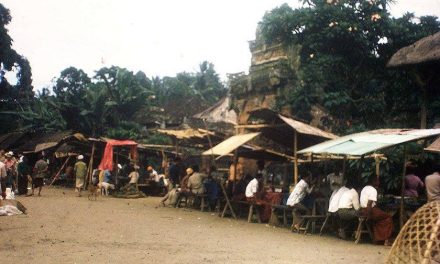When you think of Bali, images of stunning sunsets, lush rice paddies, and serene temples probably come to mind. One of the most iconic landmarks that embodies this dreamlike island is Tanah Lot. Perched dramatically on a rocky outcrop, this temple is more than just a breathtaking view; it’s a beacon of Balinese history, culture, and spirituality. Today, I invite you to join me on a journey to explore how Tanah Lot has influenced Balinese history, interspersed with personal anecdotes and insights that connect us to this vibrant culture.
A Glimpse into Balinese History
To truly understand Tanah Lot’s significance, we need to rewind the clock a bit. The history of Bali is rich and complex, influenced by waves of migration, trade, and spirituality over centuries. Legend has it that Tanah Lot was built in the 16th century by the revered Hindu priest Dang Hyang Nirartha. According to local lore, he was traveling along the coast when he discovered this beautiful spot and knew it was the perfect place to establish a temple dedicated to the sea gods.
As a traveler, I remember my first encounter with Tanah Lot. The sun was setting, casting an ethereal glow over the temple and the crashing waves below. I stood among locals and tourists alike, mesmerized by the beauty. It was then that I realized this place was not just a scenic spot; it was a living testament to Bali’s spiritual and historical essence, revered by the Balinese people.
Tanah Lot: A Connective Thread
Tanah Lot serves as a connective thread woven throughout the cultural fabric of Bali. It symbolizes the harmonious relationship between the Balinese people and the sea—a vital source of sustenance and spirituality in their lives. The temple is dedicated to the deity Baruna, who represents the sea, and is a focal point for the ceremonies that mark the agricultural calendar and seasonal changes.
During my visit, I was fortunate enough to participate in a traditional ceremony at Tanah Lot. It was a beautiful experience, infused with offerings, chanting, and an overwhelming sense of community. Locals gathered to pray, seeking blessings for bountiful harvests and safe journeys at sea. I realized that Tanah Lot is more than just a tourist attraction; it’s a living, breathing part of Balinese identity and customs.
Cultural Significance and Influence
Tanah Lot has also played a role in shaping Bali’s unique brand of Hinduism. Unlike other Hindu populations around the world, Balinese Hinduism integrates animism and ancestor worship. The temple serves as a reflection of this distinctive blend, becoming iconic not only for its spiritual significance but also for its artistic architecture, rituals, and festivals.
You might be wondering how this impacts day-to-day life in Bali. Well, here’s an anecdote: while I was exploring a local market in Canggu, I met a woman named Nyoman who sold handwoven baskets. She spoke passionately about her family’s connection to Tanah Lot, explaining how they participate in temple ceremonies and contribute to the offerings. Understanding that Tanah Lot is deeply integrated into her daily life—a source of both spirituality and community—made me appreciate its significance even more.
A Hub for Tourism and Economic Growth
The influence of Tanah Lot extends beyond spirituality; it also touches the realm of tourism and economic development. As one of Bali’s most visited sites, it draws millions of visitors each year, contributing to the local economy and providing livelihoods for many Balinese families. However, this influx also brings challenges, such as maintaining the cultural integrity of the site and managing the environment.
During my visit, I noticed how the Balinese people balance tourism with cultural preservation. They have organized initiatives aimed at protecting the environment and promoting sustainable tourism. For example, I stumbled upon a workshop led by locals that educated tourists on how to respect sacred sites while enjoying their visit. Practical advice like this can help visitors become responsible tourists, contributing positively to the communities they love to explore.
Practical Tips for Visiting Tanah Lot
For those planning a visit to Tanah Lot, here are some practical tips to enhance your experience:
1. Timing is Everything: Aim to arrive during sunset for breathtaking views. However, be prepared for crowds; planning ahead can help you find a quieter moment.
2. Dress Respectfully: As it is a sacred site, wear appropriate attire. Sarongs are often provided at the entrance, but you can also bring your own.
3. Engage with Locals: Take a moment to chat with local vendors or temple guardians. Their insights can enrich your visit and provide a deeper understanding of Balinese culture.
4. Participate in Ceremonies: If you are lucky enough to witness a ceremony, be respectful. These events are deeply significant to the community.
5. Explore the Surroundings: Don’t just rush to the temple. Spend time exploring the nearby areas, including the rocky coastline and local artisan shops.
Conclusion: Embracing the Legacy of Tanah Lot
Tanah Lot is not just a temple; it’s a historical anchor for the Balinese people, symbolizing their relationship with the sea, spirituality, and culture. My journey to Tanah Lot was more than just a visual feast; it was an enlightening experience that connected me to the heart of Bali’s history and the spirit of its people.As you plan your own adventure to Bali, remember that each visit to places like Tanah Lot is also an opportunity to engage with and appreciate the rich heritage that defines this enchanting island. Let the stories of the past and the vibrant present of Bali inspire you, and may your journey be filled with wonder and connection.






